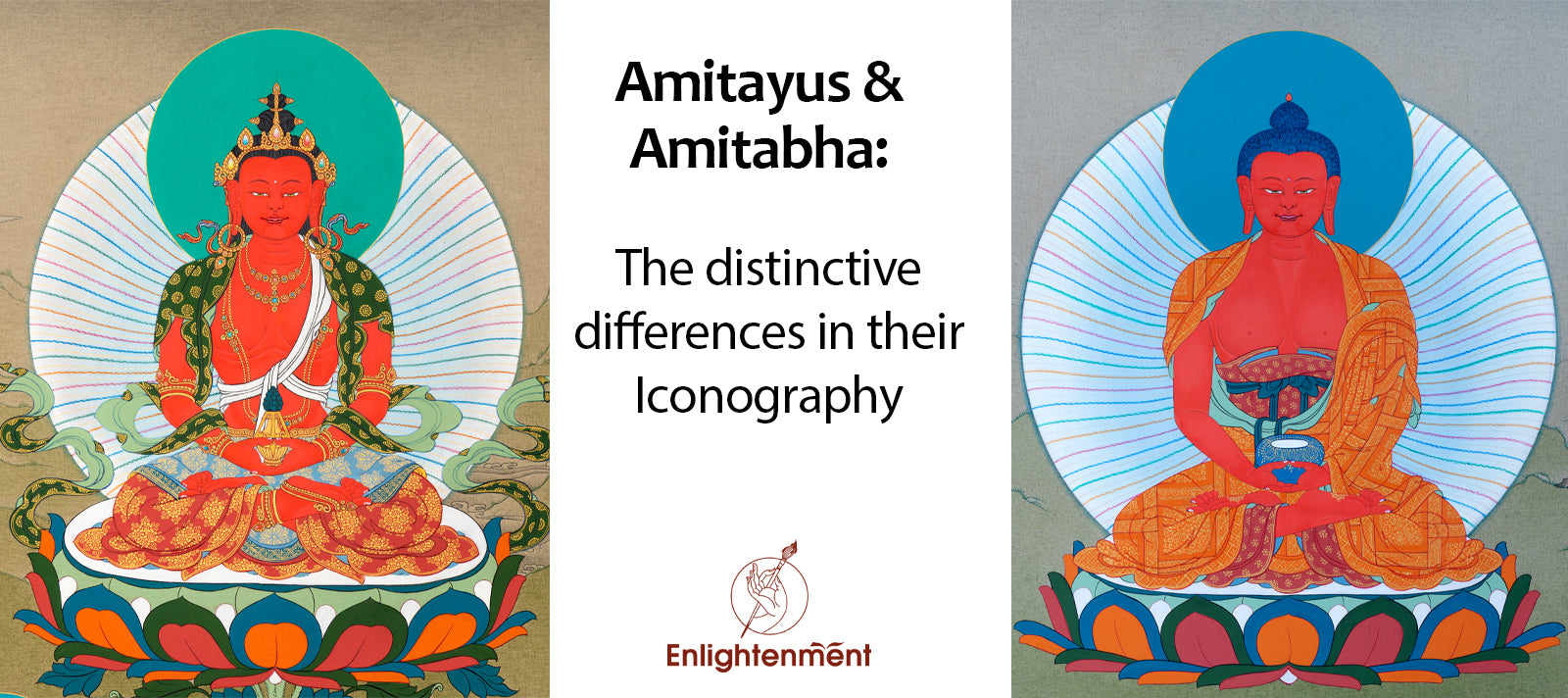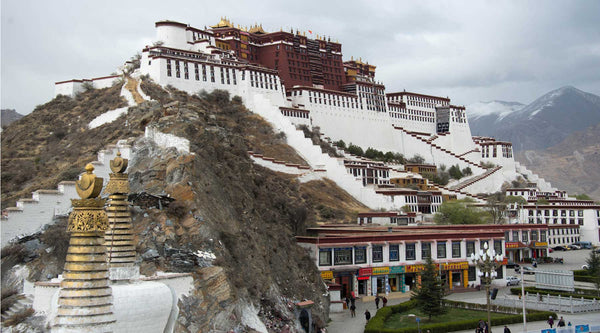Introduction to Buddha Amitabha:
Amitabha or Amitayus Buddha is one of the prominent figures of five cosmic Himalayan Esoteric Buddhism. Amitabha Buddha manifested himself as the historical Buddha Gotama and as the bodhisattva Avalokiteshvara. He is the head of Padma family, one of the Five Directional Buddha.
Amitabha is pronounced Am-mi-to in Chinese, Amida in Japanese, Amita in Korean, and A-di-da in Vietnamese. He is known as Amideva in Tibetan chants. Amitabha Buddha's followers commemorate his birth on the 17th day of the 11th lunar month.
Image Source: Termatree
He resides in a pure celestial realm which he built with the sole strength of his limitless power earned over numerous lifetimes as a Bodhisattva. His light shines brightly throughout the pure celestial realm empowering the entire cosmos. If any conscious being comes across the bright light, their defilements decadence is erased, and they are relieved and freed from agony.
Amitabha Buddha is known as Amitayus as he is the bestowal of longevity. Amitabha Pure land or Sukhavati is a celestial land, also known as Western Paradise. A pure land is where there are no distractions as practitioners meditate for Enlightenment and the final liberation.
So what is Pure land Buddhism?
The majority of teachings and Buddhist sutras of Pure Land Buddhism are based on Amitabha Buddha. It is a highly recognized form of Buddhism. Amitabha Buddha, who symbolizes pure perception and a profound understanding of emptiness, is the center of devotion in Pure Land Buddhism. This concept demonstrates the relationship between Pure Land and traditional Mahayana Buddhism. The Four Noble Truths and the Eightfold Path are the fundamental Buddhist teachings accepted by Pure Land Buddhists.
The chanting of Amitabha Buddha's name is the primary practice shared by all Pure Land sects. View our collection of Amitabha Buddha Pure land Thangka.
View our collection of Amitabha Buddha Pure land Thangka.
An Interesting Account on Buddha Amitabha:
As mentioned in the Mahayana Buddhist sutra, Amitabha was a ruler in the distant past. He was moved to such a great extent by the suffering of all living things that he abandoned his kingdom and became a monk named Dharmakara. His name means "Treasury of Dharma".
He was inspired by the teachings of the then-current Buddha, Lokesvaraja Buddha, and he aimed to become a Buddha, to establish a Buddha-land that would be devoid of all restrictions. After five eons of self-cultivation, he eventually gained the Supreme Enlightenment and transformed into the Buddha Amitabha. He set everything he learned into 48 vows. Every practitioner highly regards the 18th vow.
"If, when I attain Buddhahood, sentient beings in the lands of the ten directions who sincerely and joyfully entrust themselves to me, desire to be born in my land, and call my Name, even ten times, should not be born there, may I not attain perfect Enlightenment. Excluded, however, are those who commit the five gravest offenses and abuse the right Dharma."
Prominent Differences between Amitabha and Amitayus
The Buddha is said to have three bodies, as per the Mahayana Tradition of Buddhism:
- a form body (Nirmanakaya)
- an apparitional body (Sambhogakaya)
- an ultimate truth body (Dharmakaya)
Even though heat and light are not the same things, yet both are notions of fire. Likewise Amitabha and Amitayus are the two different aspects of the same entity.
Amitabha Buddha is the form body (Nirmanakaya), while Amitayus Buddha is the apparitional body (Sambhogkaya). Amitayus and Amitabha are mirror representations of one another. The presiding Buddha of this western paradise is sometimes referred to as Amitabha-Infinite Light and other times as Amitayus-Infinite Life in the sutras. Shakyamuni expounds the virtues of Sukhavati, the Joyous Pure Land. He is referred to as Amida ("the Infinite") in Far Eastern Buddhism, signifying that he exists outside of space, time, and all other conceptual boundaries.
Their Distinctive Iconography:
Both of the Amitabha Buddha and Amitayus appears as radiantly red body. One of the peculiar difference in their iconography is that Amitabha has a similar appearance as Buddha while Amitayus is depicted as Bodhisattva.
While Amitayus is the Buddha of Infinite Life, Amitabha is the Buddha of Infinite Light.
Amitabha holds a monk's bowl on his lap with both hands. He has one face and two hands. His eyes appear half-closed as if in deep meditation
His hair is piled atop his head and crowned with a gem top.
His hands, crossed in the Samadhi mudra of meditation, hold a gold patterned begging bowl. He is attired in the Dharma robe and sits cross-legged on a moon disc atop an exquisite lotus seat.
In contrary to this, Amitayus wears a 5 jewelled crown on his head. He has 5 silk and eight ornaments on his body and holds a Long life Vase with his both hands. He is seat in same posture as like Amitabha in a lotus seat upon a moon disc. View our Collection of Amitayus Thangka
View our Collection of Amitayus Thangka
The Connection between the Lineage:
Finally, it should be emphasized that although there is no historical connection between the lineages, Amitayus is used in Tibetan Vajrayana Buddhism for longevity meditation, and Amitabha Buddha is used in the Pure Land sects. The Pure Land sect is a Sutrayana school founded on the Amitabha sutra and does not follow the Vajrayana lineage of Amitabha. The Amitayus longevity yogas, on the other hand, refer to Amitayus as a symbol of the Vajrayana path rather than a Sutrayana character.
This is reflected in the ultimate practice. In the exoteric Vajrayana, one takes the form of Amitayus and meditates from inside the realm of genuinely being the Bodhisattva of Life and Wisdom. Amitabha is considered an external figure to be prayed to for benefits in the esoteric Vajrayana.
Amitayus Buddha Mantra:
Om Amarani Jiwantiye Soha
Amitabha Buddha Mantra: Om Ami Dewa Hrin
Om: The sound of the Eternal Universe
Ami: Infinite, limitless light
Dewa: Illuminated Deity of Buddha-nature
Hrih: With self-respect and dignity
Our minds are frequently the biggest obstacle in our way. False beliefs about oneself, the world, and one's environment can lead to significant pain in one's life. However, it may occasionally be challenging to see through this misperception.
One invokes the Amitabha Buddha's spirit, a pure consciousness free from delusion and attachment, by reciting this mantra.




1 comment
Konchok Jinpa
The mantra in Sanskit is really “Om Amtiabha Hri”; mispronounced in Tibetan as “Om Ami Dewa Hri”, similar to Tibetans not being able to pronounce “Vajra” which became “Benzar” for the VajraGuru mantra, although recently Sakya Lama Choedak Rinpoche showed in Tibetan text (Drubtab Kuntu pg.355) it’s written in Tibetan as: “Om Amrita Prabhe Amrita Hung”